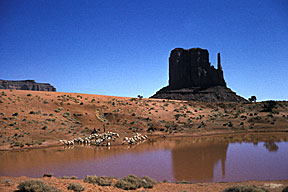|

About Fine Art Giclee Printing
Giclee (jhee-clay) - Derived from the french verb
gicler meaning to spray or squirt. The
term giclee print typically connotes a certain elevation in printmaking
technology. Images are high resolution digital scans printed with
archival quality inks onto various media like fine art canvas or
watercolor paper. In the Giclee printing process, a fine stream
of ink—millions of droplets per second—are sprayed onto
archival art paper or canvas.

Image from the Navajo Nation Circa 1950s
Monument Valley and The Navajo Indian Reservation
Artists at the printery, or atelier, work with
the image on the computer screen to get it as accurate as possible.
Because no screens are used, the prints have a higher apparent resolution
than lithographs. The dynamic color range is like serigraphy. The
fine art prints made using the Giclee printing process provides
better color accuracy than other means of reproduction. The effect
is similar to an air brush technique, but much finer.
The fine art prints made using
the Giclee printing process are advantageous to artists who find
it not feasible to mass produce their work, but want to reproduce
their art as needed or on demand. Once an image is archived, additional
reproductions can be made with minimal effort and cost. Thus the
up-front cost of mass production and the need to inventory large
quantities of finished rints are eliminated and printing is done
on demand. Another tremendous advantage to Giclee printing is
that artwork can be reproduced to almost any size and on various
media, giving the artist the ability to customize art prints to
the artlover's needs.
Contact
us and
have us give you bids and estimates on setting
up a marketing prgram for your fine art prints.
|
How do we get from an original to a Giclee reproduction? |
|
Common questions about Giclee printing |
|
What does the Giclee process cost? |
|
How images are processed for printing |
|
The shopping carts at ARTsales.com |
|
